News:
The Forgotten
Movie Houses
Princess Theatre
In December 1915, a silent movie house opened in La Crosse, The Princess. The short-lived theatre featured films from Mutual
Film Corporation, original producer of Charlie Chaplain films. Read about The Princess.
Aerdome Theatres
Aerdome Theatres (aka air domes) were outdoor motion picture or live performance theatres under the dome of the starry sky. Seating was usually in the open air with a covered stage area. There
were at least three different air domes in La Crosse at different times in the early 20th century. Visit The Aerdomes of La Crosse.
The Theatres of La Crosse, Kansas
Anyone who remembers the theaters of La Crosse, Kansas recognizes the one name synonomous with movies in La Crosse: Ralph Larned. Ralph,
along with his wife Jewel operated as many as three movie facilities in the community during their 40 year tenure. He began his career working for
Paramount Studios in Texas. After arriving in La Crosse in the late 1920s, he took over management of the Opera House (then known as the
LaCrosse Theatre. In 1950, he opened a smaller “shoebox-style” theatre on Main Street reusing the name, The LaCrosse Theatre. Four years later, he opened
the Hil'-Top Drive-In Theatre on the south edge of town.
The most memorable of his theaters was the Paramount housed in the former opera house building. Located across the corner from the courthouse on 8th Street, it was
a premiere entertainment venue in Rush County for over 60 years. The Paramount was born out of the ashes of the original Andrews Opera
House on Main Street following the great fire of 1909. This is where our story begins. And now, ladies and gentlemen on with the show...
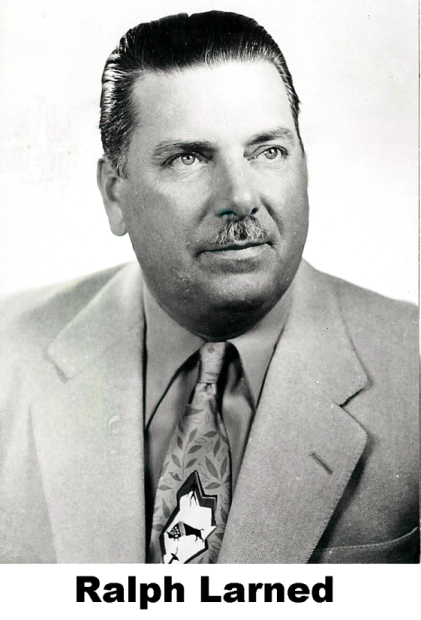 The Larned family were no strangers to the entertainment industry. When Ralph Larned
came to La Crosse from Texas in 1927 he had been working as a traveling film sales representative
for Paramount Studios. Over the years, Larned owned the three theatres in La Crosse as well
as the Jewel Theatre in Bazine (named after his wife) and the Ness Theatre in
Ness City. After leaving La Crosse in 1969, Ralph continued his career in the industry as a theatre manager in Texas.
The Larned family were no strangers to the entertainment industry. When Ralph Larned
came to La Crosse from Texas in 1927 he had been working as a traveling film sales representative
for Paramount Studios. Over the years, Larned owned the three theatres in La Crosse as well
as the Jewel Theatre in Bazine (named after his wife) and the Ness Theatre in
Ness City. After leaving La Crosse in 1969, Ralph continued his career in the industry as a theatre manager in Texas.
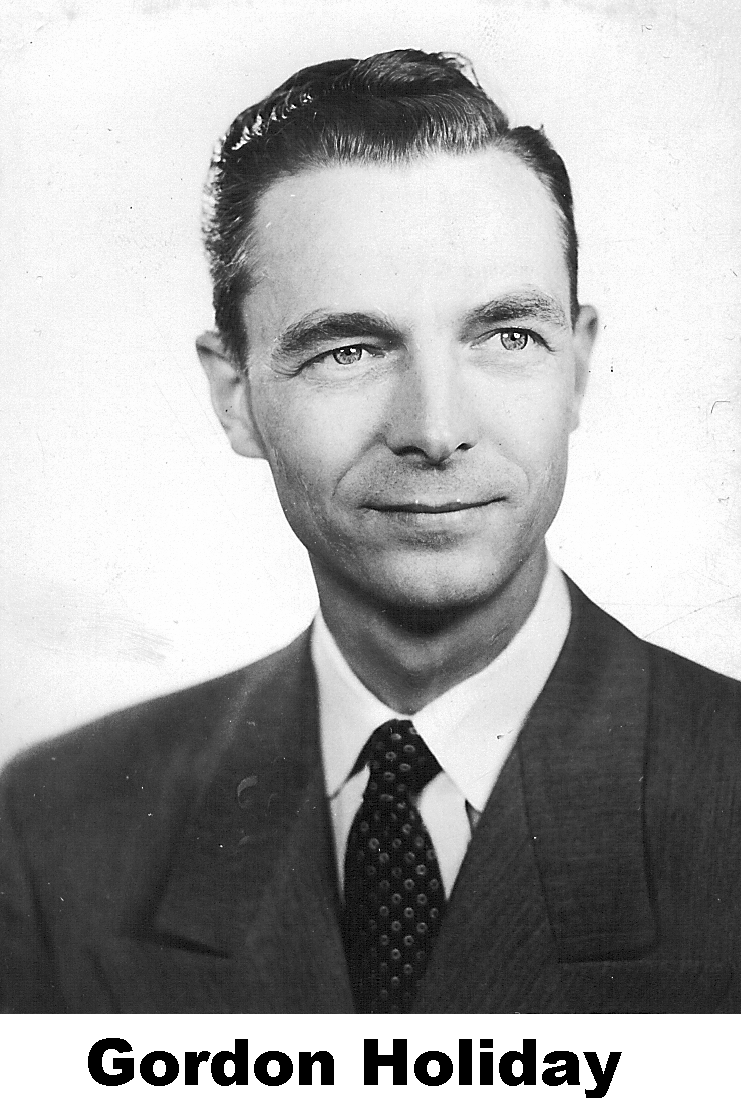
Gordon Holiday, moved to La Crosse and assumed the manager's position of the theatres after
he was discharged from the service following the war. Gordon was married to Courtney Meredith,
daughter of the Larneds. Courtney, a graduate of the Kansas City Art Institute, was well-known
for her dancing and stage performances in area pageants.
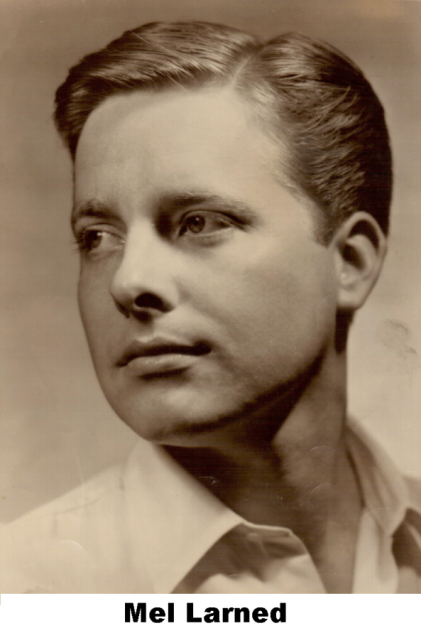 Ralph and Jewel's son, Melville Kent (Mel) Larned was well on his way to a brilliant career on stage and television
when his died suddenly of leukemia in July 1955. Mel graduated from La Crosse High School in 1943 and served
in the Army Corp of Engineers during the war. He studied music at Biarritz University in France before returning to
the U.S. and graduating from Louisiana State University. Launching his career in 1950, he worked closely with Ray Charles and appeared on the “Perry Como Show”, “Ford All-Star Review”,
and “Hit Parade”. In January 1954, he recorded on the RCA Victor label as a vocalist in the chorus for Harry Belafonte's “I'm Just a Country Boy”, “Hold 'Em Joe”, “Acorn in the Meadow”, and “Pretty as a Rainbow”.
His most recent accomplishment had been on the New York stage in the production
of “Shoestring Revue” alongside well-known stars including Beatrice Arthur, Chita Rivera, and Dody Goodman. He had credits of over 300 television shows, commercials, and dramatic parts at the time of his death.
Ralph and Jewel's son, Melville Kent (Mel) Larned was well on his way to a brilliant career on stage and television
when his died suddenly of leukemia in July 1955. Mel graduated from La Crosse High School in 1943 and served
in the Army Corp of Engineers during the war. He studied music at Biarritz University in France before returning to
the U.S. and graduating from Louisiana State University. Launching his career in 1950, he worked closely with Ray Charles and appeared on the “Perry Como Show”, “Ford All-Star Review”,
and “Hit Parade”. In January 1954, he recorded on the RCA Victor label as a vocalist in the chorus for Harry Belafonte's “I'm Just a Country Boy”, “Hold 'Em Joe”, “Acorn in the Meadow”, and “Pretty as a Rainbow”.
His most recent accomplishment had been on the New York stage in the production
of “Shoestring Revue” alongside well-known stars including Beatrice Arthur, Chita Rivera, and Dody Goodman. He had credits of over 300 television shows, commercials, and dramatic parts at the time of his death.
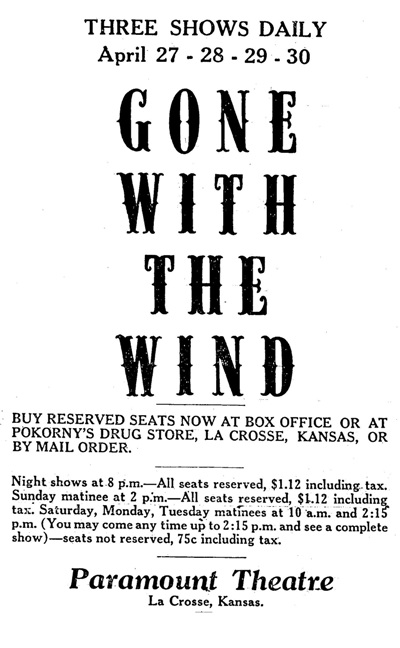
In 1940, the Paramount featured one of the most highly anticipated movies of the time,
“Gone With the Wind” with the local premiere being a community event. Stores
offered “Gone With the Wind” specials, posters were in store windows, and the newspaper was
filled with advertisements related to the movie. Reserved seat tickets were offered for sale at local stores, the theatre box office, or by mail for a
price of one dollar each plus 12 cents tax.
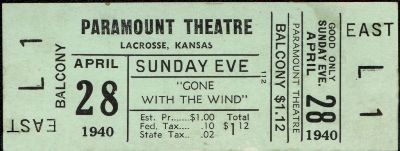
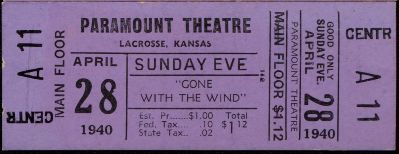 For years afterwards, the large billboard advertising the movie remained on the side of the theatre. Traces of
the sign were still visible when the building was razed in 1981.
For years afterwards, the large billboard advertising the movie remained on the side of the theatre. Traces of
the sign were still visible when the building was razed in 1981.


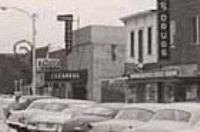


 The Larned family were no strangers to the entertainment industry. When Ralph Larned
came to La Crosse from Texas in 1927 he had been working as a traveling film sales representative
for Paramount Studios. Over the years, Larned owned the three theatres in La Crosse as well
as the Jewel Theatre in Bazine (named after his wife) and the Ness Theatre in
Ness City. After leaving La Crosse in 1969, Ralph continued his career in the industry as a theatre manager in Texas.
The Larned family were no strangers to the entertainment industry. When Ralph Larned
came to La Crosse from Texas in 1927 he had been working as a traveling film sales representative
for Paramount Studios. Over the years, Larned owned the three theatres in La Crosse as well
as the Jewel Theatre in Bazine (named after his wife) and the Ness Theatre in
Ness City. After leaving La Crosse in 1969, Ralph continued his career in the industry as a theatre manager in Texas.

 Ralph and Jewel's son, Melville Kent (Mel) Larned was well on his way to a brilliant career on stage and television
when his died suddenly of leukemia in July 1955. Mel graduated from La Crosse High School in 1943 and served
in the Army Corp of Engineers during the war. He studied music at Biarritz University in France before returning to
the U.S. and graduating from Louisiana State University. Launching his career in 1950, he worked closely with Ray Charles and appeared on the “Perry Como Show”, “Ford All-Star Review”,
and “Hit Parade”. In January 1954, he recorded on the RCA Victor label as a vocalist in the chorus for Harry Belafonte's “I'm Just a Country Boy”, “Hold 'Em Joe”, “Acorn in the Meadow”, and “Pretty as a Rainbow”.
His most recent accomplishment had been on the New York stage in the production
of “Shoestring Revue” alongside well-known stars including Beatrice Arthur, Chita Rivera, and Dody Goodman. He had credits of over 300 television shows, commercials, and dramatic parts at the time of his death.
Ralph and Jewel's son, Melville Kent (Mel) Larned was well on his way to a brilliant career on stage and television
when his died suddenly of leukemia in July 1955. Mel graduated from La Crosse High School in 1943 and served
in the Army Corp of Engineers during the war. He studied music at Biarritz University in France before returning to
the U.S. and graduating from Louisiana State University. Launching his career in 1950, he worked closely with Ray Charles and appeared on the “Perry Como Show”, “Ford All-Star Review”,
and “Hit Parade”. In January 1954, he recorded on the RCA Victor label as a vocalist in the chorus for Harry Belafonte's “I'm Just a Country Boy”, “Hold 'Em Joe”, “Acorn in the Meadow”, and “Pretty as a Rainbow”.
His most recent accomplishment had been on the New York stage in the production
of “Shoestring Revue” alongside well-known stars including Beatrice Arthur, Chita Rivera, and Dody Goodman. He had credits of over 300 television shows, commercials, and dramatic parts at the time of his death.


 For years afterwards, the large billboard advertising the movie remained on the side of the theatre. Traces of
the sign were still visible when the building was razed in 1981.
For years afterwards, the large billboard advertising the movie remained on the side of the theatre. Traces of
the sign were still visible when the building was razed in 1981.